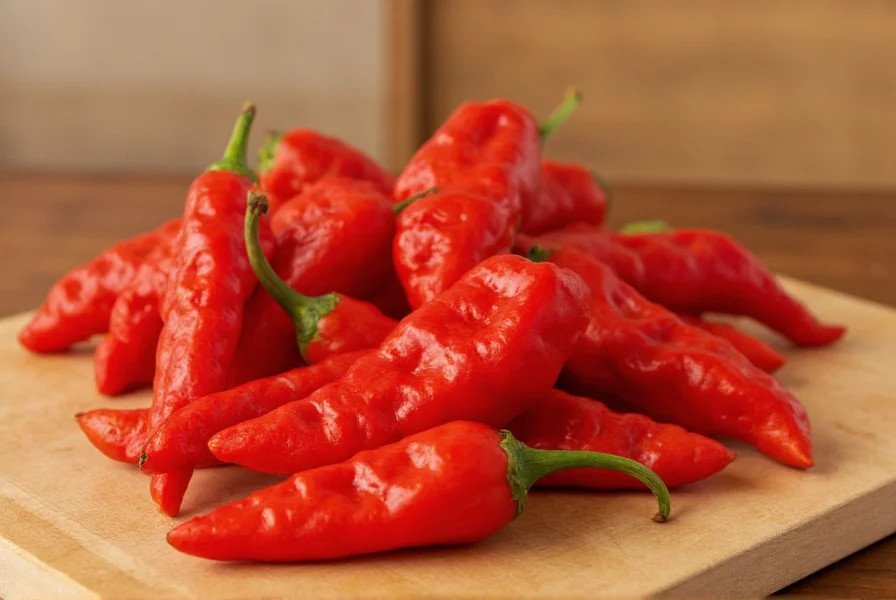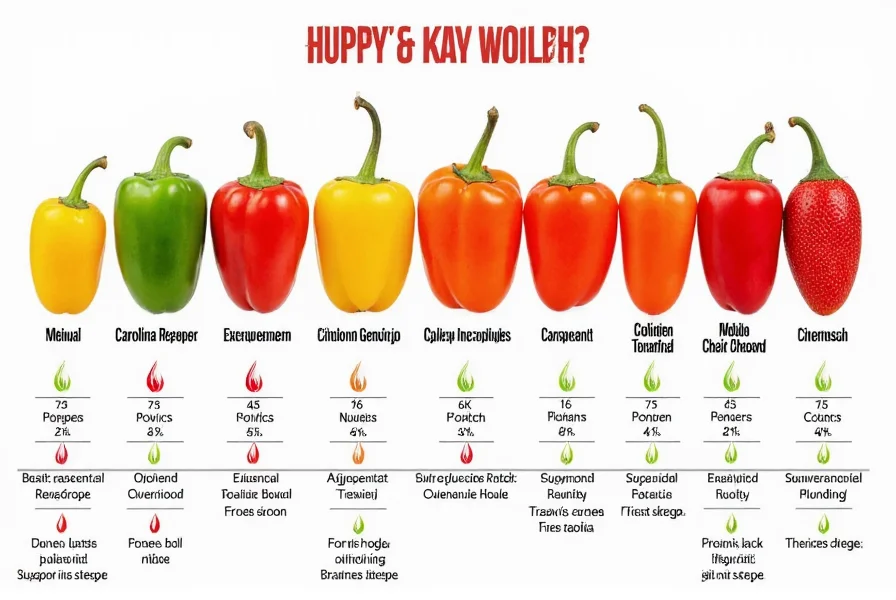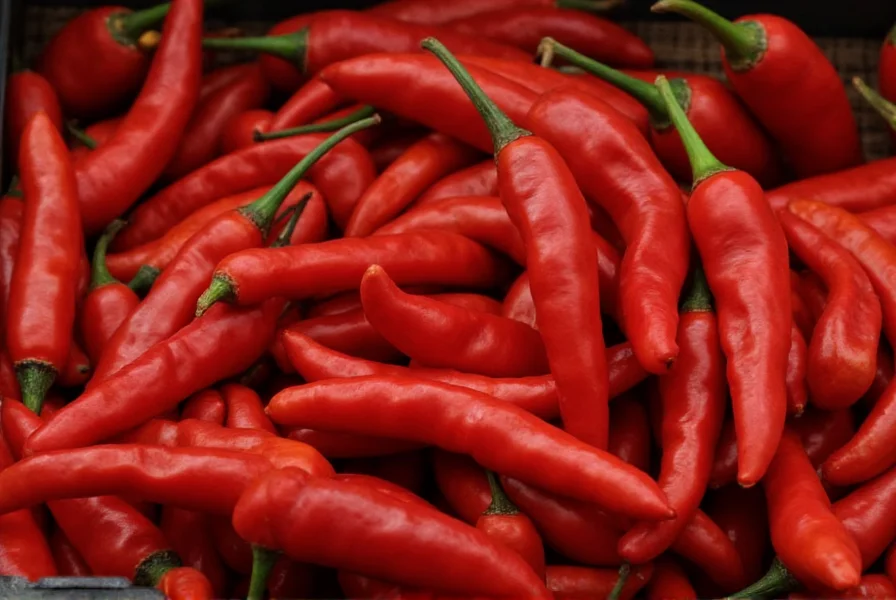Understanding the world's hottest chili pepper requires examining both scientific measurement and practical implications. The Scoville scale, developed by pharmacist Wilbur Scoville in 1912, remains the standard for measuring chili heat through capsaicin concentration. While many peppers claim extreme heat, only those verified through laboratory testing using high-performance liquid chromatography (HPLC) receive official recognition.
The Carolina Reaper's distinctive appearance features a bumpy red body with a characteristic stinger-like tail. When properly cultivated, these peppers reach 1-2 inches in length and deliver a complex flavor profile that begins with sweet, fruity notes before unleashing their signature intense heat. This dual-phase experience makes the Carolina Reaper particularly challenging to handle, as the initial pleasant flavor can mask the extreme heat that follows.
| Pepper Variety | Average SHU | Peak SHU | Guinness Recognition | Origin |
|---|---|---|---|---|
| Carolina Reaper | 1,641,183 | 2,200,000 | Official Record Holder (2013-2023) | South Carolina, USA |
| Pepper X | 3,180,000 | 3,500,000 | Pending Verification | South Carolina, USA |
| Dragon's Breath | 2,480,000 | 2,483,850 | Not Officially Recognized | Wales, UK |
| Trinidad Moruga Scorpion | 1,200,000 | 2,009,231 | Previous Record Holder | Trinidad and Tobago |
| Naga Viper | 1,382,118 | 1,349,000 | Previous Record Holder | UK |
Ed Currie spent over ten years developing the Carolina Reaper through selective breeding of Pakistani Naga and Red Habanero peppers. The goal wasn't merely to create extreme heat but to develop a pepper with complex flavor characteristics alongside its formidable Scoville rating. Currie's work with the Chile Pepper Institute at New Mexico State University helped validate the pepper's heat levels through proper scientific testing.
When handling Carolina Reaper peppers, safety precautions are essential. Capsaicin, the compound responsible for chili heat, can cause severe skin irritation and respiratory issues. Professional growers and handlers recommend wearing nitrile gloves, eye protection, and even respirators when processing these peppers. Never touch your face after handling super-hot peppers, and keep them away from children and pets.

The physiological effects of consuming Carolina Reaper peppers extend beyond simple discomfort. Many people experience the 'reaper headache'—a severe, temporary headache caused by capsaicin's effect on trigeminal nerve receptors. In extreme cases, consumption has led to thunderclap headaches requiring medical attention. The body's response includes sweating, flushing, increased heart rate, and sometimes temporary numbness.
Culinary applications for the Carolina Reaper require extreme caution and precision. Chefs typically use microscopic amounts—often measured in drops of infused oil rather than whole peppers—to add heat without overwhelming other flavors. The pepper's initial fruity flavor makes it valuable in certain hot sauces, but its extreme heat limits widespread culinary use. Many commercial products featuring Carolina Reaper undergo careful dilution to create manageable heat levels for consumers.
Scientifically, the Carolina Reaper's heat results from exceptionally high concentrations of capsaicinoids, particularly capsaicin and dihydrocapsaicin. These compounds trigger TRPV1 receptors in the mouth and skin, which normally respond to actual heat (around 42°C/107.6°F). This neurological trick makes your body perceive actual burning sensations when none is physically present.
Several contenders have emerged claiming to surpass the Carolina Reaper's heat. Pepper X, also developed by Ed Currie, reportedly measures up to 3.18 million SHU based on preliminary HPLC testing. Dragon's Breath, created in Wales, claims 2.48 million SHU but lacks independent verification. The7 Pot Douglah and Moruga Trinidad Scorpion remain among the hottest verified peppers, though they fall short of the Carolina Reaper's officially recognized peak measurements.
For those interested in growing Carolina Reaper peppers, specific conditions are required. These plants need 90-120 days to mature, prefer temperatures between 70-90°F (21-32°C), and require careful watering to prevent stress that might reduce heat levels. The peppers change from green to bright red when fully mature and ready for harvest. Many growers report that stress factors like limited water or nutrient deficiency can actually increase capsaicin production, making the peppers hotter but potentially reducing overall yield.

Understanding pepper heat requires context beyond absolute numbers. The Scoville scale is logarithmic, meaning each step represents a tenfold increase in capsaicin concentration. A Carolina Reaper at 2 million SHU is not merely twice as hot as a Habanero at 100,000 SHU—it's twenty times hotter. This exponential relationship explains why moving up the scale creates dramatically different physical experiences.
As research continues, new breeding techniques and genetic understanding may produce even hotter peppers. However, practical limitations exist—peppers beyond a certain heat threshold become increasingly difficult to handle safely and offer diminishing culinary value. The current frontier of extreme heat peppers represents both a scientific achievement and a practical challenge for growers, handlers, and consumers alike.
Frequently Asked Questions
How dangerous is the Carolina Reaper pepper?
While not lethal in normal consumption amounts, the Carolina Reaper can cause severe discomfort including intense burning sensations, sweating, nausea, and temporary breathing difficulties. In rare cases, extreme consumption has led to esophageal tears and thunderclap headaches requiring medical attention. Proper handling with gloves and eye protection is essential when processing these peppers.
What does the Carolina Reaper taste like beyond the heat?
Before the intense heat registers, the Carolina Reaper offers a surprisingly complex flavor profile with sweet, fruity notes reminiscent of cherries and apples, followed by cinnamon and citrus undertones. This initial flavor complexity is why it's valued by hot sauce makers despite its extreme heat. The heat typically builds 30-45 seconds after consumption, peaking at 1-2 minutes.
How should I treat skin contact with Carolina Reaper oil?
If Carolina Reaper oil contacts your skin, immediately wash with soap and cold water (hot water opens pores). Apply milk, yogurt, or a dairy-based product to the affected area, as casein helps break down capsaicin. Avoid touching other body parts, especially eyes. For severe reactions, seek medical attention. Never use alcohol or vinegar, as they can spread the oil and worsen the reaction.
Can you build tolerance to super-hot peppers like the Carolina Reaper?
Yes, regular consumption of capsaicin can build temporary tolerance as it depletes substance P in nerve endings. However, this tolerance resets after several days without exposure. Professional eaters develop higher tolerance through gradual exposure, but even experienced handlers can be overwhelmed by the Carolina Reaper's extreme heat. Tolerance varies significantly between individuals based on genetics and previous exposure.











 浙公网安备
33010002000092号
浙公网安备
33010002000092号 浙B2-20120091-4
浙B2-20120091-4